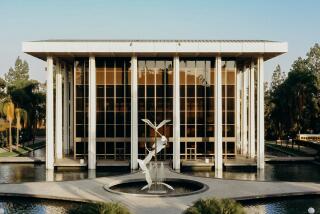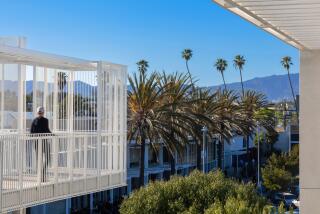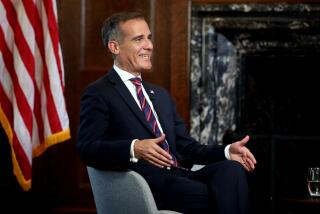Embassy Row receives an exotic face lift
Washington — Surveying his newly completed official residence, Spain’s ambassador to the United States enthuses, “The moment you get into these spaces you feel elation.” That sense is contagious, because the envoy, Javier Ruperez, can entertain 500 guests for cocktails in his barrel-vaulted living room, a splendid arena hung with paintings on loan from the Prado and the Reina Sofia museums in Madrid.
Designed by Pritzker Prize-winning architect Jose Rafael Moneo, the 20,000-square-foot house also contains a formal dining room with an oak table that can seat 40. Moneo’s multilevel creation -- an Iberian take on the cubic forms of Bauhaus architecture -- cascades down a steeply raked, narrow tract along Foxhall Road in northwest Washington.
Jose Maria Aznar, outgoing prime minister of Spain, dedicated the $10-million residence in January, the latest in a series of impressive embassy complexes built in the U.S. capital over the last few years. More major embassy projects are in the works.
Construction of an imposing Chinese mission, designed by I.M. Pei and his two sons, is due to get underway this year. Sweden is building a strikingly modern complex overlooking the Potomac River near the Kennedy Center. Switzerland has recently announced plans for a $10-million residence for its ambassador, designed by New York architect Steven Holl in conjunction with Swiss architect Justin Russli.
Construction crews work busily on still more renovations and expansions up and down Embassy Row, a flag-bedecked stretch of Massachusetts Avenue from Dupont Circle to the National Cathedral on Wisconsin Avenue. “Washington is a power center in the world, and embassies want to represent themselves well here,” said Lenwood Dent, deputy head of the State Department’s Office of Foreign Missions.
Although Spain’s ambassadorial residence and embassy is earning acclaim, not everyone is pleased with the architectural quality of several other embassies going up around town. A new enclave for foreign missions, specially created by the State Department, has filled with an array of exotic and even cartoonish-looking structures.
Embassy buildings frequently have been used to project images of the countries they represent, effectively becoming large-scale advertisements for their nations. When the then-fledgling Federal Republic of Germany built a Washington embassy in 1964, it carefully chose a low-key design by West German architect Egon Eiermann. With the building’s simple and humanely proportioned facade, the state that arose from Nazi Germany’s ashes acquired a billboard image proclaiming that it had changed its bellicose ways.
Because of an embassy’s symbolic significance in a major capital such as Washington, architects are inclined to approach its design differently from most commercial projects. In many cases, they take particular care in consulting diplomatic clients about the building’s visual impact. “The idea of Chinese diplomats is to express the importance of the country without going and beating their breast about it,” said C.C. Pei, a son of I.M. Pei, whose firm, Pei Partnership Architects, is drawing up the Chinese Embassy.
Since the fall of communism and the split-up of the Soviet Union, an increasing number of new nations have sought U.S. premises for their diplomatic delegations. A total of 175 countries are represented in Washington. More than 80 embassies have been built here over the last 25 years either as a result of newly established diplomatic ties or existing missions moving to new premises, according to the National Capital Planning Commission.
An average of four embassies -- either an ambassadorial residence or chancery facilities housing diplomatic offices -- is expected to be built each year in Washington.
For decades, most foreign countries moved into former mansions built around Washington in the early 20th century. Many nations have outgrown these premises, and the latest generation of purpose-built embassies tends to be far more lavish and architecturally distinctive. “We’re getting larger facilities, and we’re getting showcases,” said George Toop, head of the Planning Commission’s foreign mission task force. “We’re looking at centers for marketing and development.”
‘Embassy Acres’
Italy’s vast new embassy, an almost surrealistic interpretation of a palazzo, has a central atrium that has been used to display Ferrari sports cars. Daubed bright yellow and red, it is filled with modern Italian furniture and antiquities and leads to a cafe plastered with huge images of film stars Gina Lollobrigida, Sophia Loren and Marcello Mastroianni. The $36-million building, completed three years ago, was created by Rome architect Piero Sartogo, who previously designed the Bulgari jewelry showroom on New York’s Fifth Avenue.
This spring, Finland’s embassy houses a traveling exhibition of colorful, trend-setting textiles by Helsinki manufacturer Marimekko. The Finnish building, a green-hued rectangle fashioned out of glass, copper, bronze and highly polished granite, has demonstrated how nations can use embassy architecture to considerable effect since it opened on Massachusetts Avenue in 1994. “It set off a buzz in the whole city,” architectural historian Jane Loeffler said. “Everybody wanted to go there and be there and be connected through that building to little unknown Finland. It’s amazing how they established an identity with that building and programs within it.”
China’s embassy will be the latest addition to the State Department’s specially created district known as the International Chancery Center, a few miles north of Embassy Row. Within this 34-acre area that originally consisted of 23 separate lots, the State Department and federal planning bodies have encouraged the use of foreign architectural elements, a policy that has spawned a compound akin to a suburban subdivision with an amusement park feel.
Outside the Egyptian Embassy, sheathed in gray granite, a large Pharaonic gateway looms at the entrance, looking almost as if it had been transported from Luxor. The embassy of the United Arab Emirates is a fantasy concoction out of “The Arabian Nights” with such traditional Islamic motifs as diamond shapes and latticework.
Malaysia’s embassy has a golden spire atop its folkloric tiled roof. Austria makes a tepid attempt to evoke Wiener Werkstatte decorations on its embassy’s facade. The Israeli and Jordanian embassies, a few moments’ walk from each other, use arched windows typical of the Middle East.
Remarkably, most of these buildings were designed by American architects. Pakistan’s new $15-million embassy, completed at the enclave last autumn, was drawn up by the Arlington, Va., office of DMJM Design. That firm sent a team to tour Pakistan in search of inspiration, finding it in elements of key historic monuments, including the arched roof of a Moghul fortress, colorful decorative tiles, pointed windows and polished marble floors with multicolor sunburst patterns.
Architectural historian Loeffler, an expert in U.S. and foreign embassy design, compares this transplantation of vernacular architecture to the U.S. building a replica of the White House or a log cabin as its embassy in a country such as Oman. In fact, the U.S. Embassy in Muscat was designed in the 1980s by James Stewart Polshek, who was inspired by traditional Islamic architecture with segmented archways, courtyards and banded stonework. But more U.S. embassies built in more recent years generally don’t stand out for security reasons.
Martin Moeller, National Building Museum vice president, who is preparing a new American Institute of Architects guide to Washington, derides the campus-like Chancery Center as “Embassy Acres,” saying it overflows with “cheesy uses of pseudo local motifs.” It earned similar opprobrium from Washington Post architecture critic Benjamin Forgey, who sees the enclave as “a world’s fair of dolled-up embassies.”
By contrast, visitors to the Spanish ambassador’s residence find that Moneo, who also designed the Cathedral of Our Lady of the Angels in Los Angeles and an addition to the Museum of Fine Arts in Houston, avoided anything explicitly Spanish, instead hinting at Andalusian and Moorish influences through extensive brickwork, patios and terraces.
But the State Department and the two federal bodies that oversee construction in Washington -- the U.S. Commission of Fine Arts and the National Capital Planning Commission -- are committed to encouraging the overt use of foreign motifs at the Chancery Center. (Now that the complex is full -- Morocco has leased the sole remaining plot -- the State Department is looking for new property on which to create a second enclave.)
Echo rather than caricature
The Fine Arts commission, headed by architect David Childs, who succeeded longtime chairman and National Gallery of Art director J. Carter Brown, has requested numerous changes to Washington embassy projects but in the end has done little to thwart bad embassy design. This could stem from a desire to avoid international incidents by not ruffling foreign feathers. Most embassy projects in Washington are not subject to federal review, though those within the International Chancery Center come under commission purview because the property, owned by the State Department, is leased on a long-term basis to foreign governments.
When the commission reviewed plans for a building that Qatar is renovating as its embassy on another site in northwest Washington, it pushed for a design that reflected the Persian Gulf emirate’s architectural tradition. “The first scheme we saw was very timid and we said, ‘Come on, guys, let’s have it expressive of the country and the customs,’ ” commission assistant secretary Frederick Lindstrom said.
Many foreign diplomats have no problem with this approach. However, the architect of the recently completed Nigerian Embassy says the country’s ambassador was uninterested in design that derived from African precedents. “To them it was relatively meaningless,” said Robert Sponseller, a principal at the Washington architecture firm of Shalom Baranes. “They wanted a very forward-looking building.”
Sponseller reached a compromise by creating a functional skylighted building that is contemporary in character yet evokes traditional West African architecture. At the Chinese Embassy, which the Pei Partnership calls “a contemporary interpretation of traditional Chinese architectural planning,” the architects are using ornamental gardens, a prismatic roof and other distinctive geometrical forms to subtly suggest China without resorting to copying a pagoda. Like Moneo’s building for the Spanish ambassador, the best new diplomatic architecture in Washington tends to quietly echo rather than caricature whence it comes.


